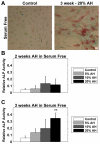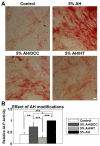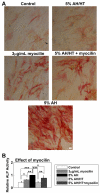Thermally labile components of aqueous humor potently induce osteogenic potential in adipose-derived mesenchymal stem cells
- PMID: 25720657
- PMCID: PMC4446238
- DOI: 10.1016/j.exer.2015.02.018
Thermally labile components of aqueous humor potently induce osteogenic potential in adipose-derived mesenchymal stem cells
Abstract
Adipose-derived mesenchymal stem cells (ASCs) hold promise for use in cell-based therapies. Their intrinsic anti-inflammatory properties are potentially useful for treatments of inflammatory conditions such as uveitis, while their ability to differentiate along multiple cell lineages suggests use in regenerating damaged or degenerated tissue. However, how ASCs will respond to the intraocular environment is poorly studied. We have recently reported that aqueous humor (AH), the fluid that nourishes the anterior segment of the eye, potently increases alkaline phosphatase (ALP) activity of ASCs, indicating osteogenic differentiation. Here, we expand on our previous findings to better define the nature of this response. To this end, we cultured ASCs in the presence of 0, 5, 10, and 20% AH and assayed them for ALP activity. We found ALP activity correlates with increasing AH concentrations from 5 to 20%, and that longer treatments result in increased ALP activity. By using serum free media and pretreating AH with dextran-coated charcoal, we found that serum and charcoal-adsorbable AH components augment but are not required for this response. Further, by heat-treating the AH, we established that thermally labile components are required for the osteogenic response. Finally, we showed myocilin, a protein present in AH, could induce ALP activity in ASCs. However, this was to a lesser extent than untreated 5% AH, and myocilin could only partially rescue the effect after heat treatment, documenting there were additional thermally labile constituents of AH involved in the osteogenic response. Our work adds to the understanding of the induction of ALP in ASCs following exposure to AH, providing important insight in how ASCs will be influenced by the ocular environment. In conclusion, increased osteogenic potential upon exposure to AH represents a potential challenge to developing ASC cell-based therapies directed at the eye.
Keywords: Alkaline phosphatase; Aqueous humor; Mesenchymal stem cells; Myocilin; Osteogenic potential.
Copyright © 2015 Elsevier Ltd. All rights reserved.
Figures




Similar articles
-
Pulsed electromagnetic fields stimulate osteogenic differentiation in human bone marrow and adipose tissue derived mesenchymal stem cells.Bioelectromagnetics. 2014 Sep;35(6):426-36. doi: 10.1002/bem.21862. Epub 2014 Aug 6. Bioelectromagnetics. 2014. PMID: 25099126
-
Influence of mechanical fluid shear stress on the osteogenic differentiation protocols for Equine adipose tissue-derived mesenchymal stem cells.Acta Histochem. 2019 Apr;121(3):344-353. doi: 10.1016/j.acthis.2019.02.002. Epub 2019 Feb 23. Acta Histochem. 2019. PMID: 30808518
-
Osteogenic differentiation of equine adipose tissue derived mesenchymal stem cells using CaCl2.Res Vet Sci. 2018 Apr;117:45-53. doi: 10.1016/j.rvsc.2017.11.010. Epub 2017 Nov 21. Res Vet Sci. 2018. PMID: 29175012
-
WNT3A and the induction of the osteogenic differentiation in adipose tissue derived mesenchymal stem cells.Tissue Cell. 2017 Aug;49(4):489-494. doi: 10.1016/j.tice.2017.05.004. Epub 2017 May 12. Tissue Cell. 2017. PMID: 28549605
-
Analysis of pharmaceuticals and small molecules in aqueous humor.J Pharm Biomed Anal. 2018 Sep 10;159:23-36. doi: 10.1016/j.jpba.2018.06.049. Epub 2018 Jun 25. J Pharm Biomed Anal. 2018. PMID: 29980016 Review.
Cited by
-
Adipose Stem Cells in Modern-Day Ophthalmology.Clin Pract. 2023 Feb 4;13(1):230-245. doi: 10.3390/clinpract13010021. Clin Pract. 2023. PMID: 36826163 Free PMC article. Review.
References
-
- Arnalich-Montiel F, Pastor S, Blazquez-Martinez A, Fernandez-Delgado J, Nistal M, Alio JL, De Miguel MP. Adipose-derived stem cells are a source for cell therapy of the corneal stroma. Stem Cells. 2008;26:570–579. - PubMed
-
- Bellows CG, Aubin JE, Heersche JN. Physiological concentrations of glucocorticoids stimulate formation of bone nodules from isolated rat calvaria cells in vitro. Endocrinology. 1987;121:1985–1992. - PubMed
-
- Bellows CG, Aubin JE, Heersche JN, Antosz ME. Mineralized bone nodules formed in vitro from enzymatically released rat calvaria cell populations. Calcif Tissue Int. 1986;38:143–154. - PubMed
Publication types
MeSH terms
Substances
Grants and funding
LinkOut - more resources
Full Text Sources
Other Literature Sources
Miscellaneous

